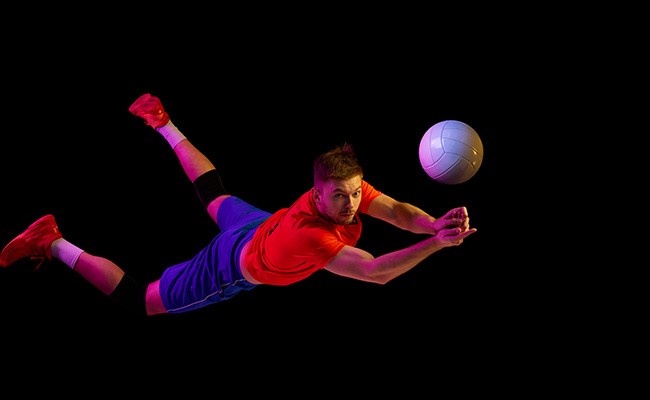
Acute and overuse sports injuries in volleyball
- 02/03/2023
How common are sports injuries in volleyball?
Sports trauma studies have provided information on the most common acute and overuse injuries in this sport. The incidence of injuries is estimated to be between 1.7 and 18.6 per 1,000 hours of practice (with no consensus on which are acute and which are overuse injuries).
Volleyball is one of the most popular team sports in the world. It is estimated that around 500 million people in 220 countries play the sport, according to data provided by the International Volleyball Federation. Countless sports trauma studies address the frequency, incidence, and causes of overuse injuries in volleyball.
When compared to other widely practiced team sports worldwide, we find that the injury incidence in volleyball is similar to that of basketball (7.6-15.2/1000h), lower than that of soccer (20.3-37.2/1000h), and higher than that of handball (3.4-5.7/1000h).
What are the most common diagnoses of sports injuries in volleyball?
Acute injuries are the most common, and among these are injuries to the ankle (13.8-81.5%), knee (16-30%), wrist (15-60%), and fingers. In the ankle, the most common injury is a sprain of the anterior talofibular ligament, part of the lateral ligament complex of the ankle. In the knee, the most common acute injury is a rupture of the anterior cruciate ligament. Injuries that occur in the wrists and fingers are usually contusions, sprains, fractures, traumatic arthritis, and dislocations.
Acute ankle and knee injuries are explained by the intensity of changes of pace, jumping, and landing, while finger and wrist injuries are explained by direct contact with the ball during spikes, catches, or blocks.
On the other hand, overuse injuries tend to affect the shoulder (9-40%), knee (16-30%), and lumbar spine (10-11%). They usually result in longer sideline times and are secondary to the game itself. Regarding the shoulder, overhead activity such as serving, spikes, and blocks contributes to this injury. Jumping sports, such as volleyball, place significant stress on the patellar tendon, which is why patellar tendonitis is the most common overuse injury of the knee (also known as jumper's knee). Senior players combine reduced lumbar mobility with repetitive lumbar hyperextensions typical of the game, these two factors being co-responsible for low back pain as an overuse injury.
Various sports trauma studies have not found significant differences in injury incidence by gender, but they have when comparing these injuries by age group. Hand injuries are more common in young, novice players, while overuse injuries affecting the lumbar spine are more common in senior players.
How serious are sports injuries in volleyball?
Regarding injury severity, it should be noted that many acute injuries tend to be mild or moderate, and the vast majority of them allow players to continue playing the sport.
At what point in the game do sports injuries occur in volleyball?
If we look at the literature on the most injurious time of the game, we find that more injuries occur in competition than in training sessions. Regarding the most common time of the season, we find that this period is the preseason. The most injured players are those in forward positions (in order: opposite, middle, and zone 4 spikers), primarily due to spikes and blocks.
How can sports injuries be prevented in volleyball?
Preventive measures during the preseason are essential. Correct scheduling and load management can help improve a player's adaptation to exercise, reducing the percentage of injuries and preventing performance losses.
Book an appointment with Dr. Jordi Jiménez. He will see you at the center of Palma de Mallorca and help you regain your quality of life.

![[VIDEO] Ultrasound-Guided Injection for Trigger Finger](https://drjordijimenez.com/imagen/100/100/Imagenes/infiltracion-ecoguidada-dedo-resorte-drjordijimenez.jpg)
![[VIDEO] Ultrasound-guided infiltration of the lumbar facets](https://drjordijimenez.com/imagen/100/100/imagenes-pagina/sindrome-facetario-lumbar-drjordijimenez (1).jpg)
![[VIDEO] Ultrasound-guided infiltration of the hip joint](https://drjordijimenez.com/imagen/100/100/Imagenes/valgo-dinamico-rodilla-drjordijimenez.jpg)